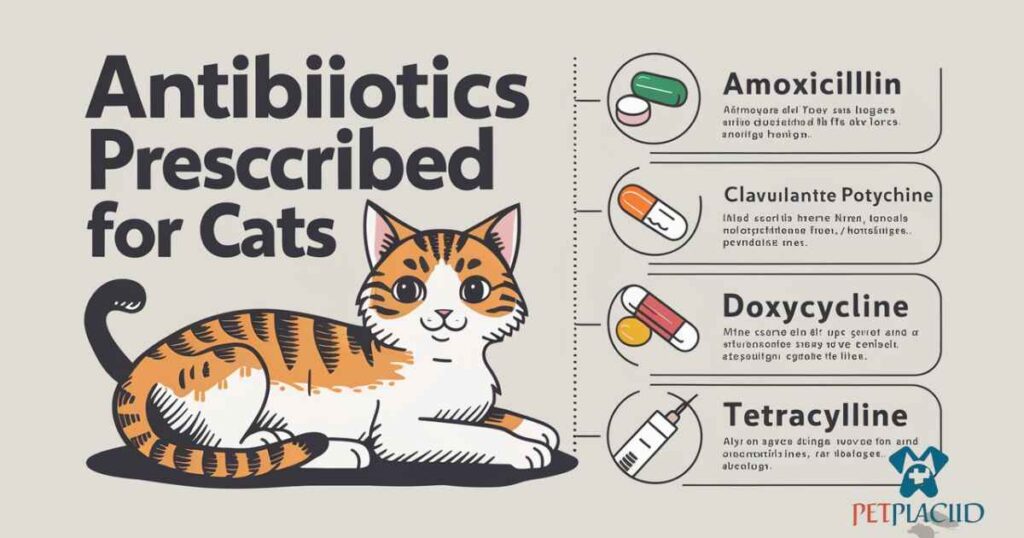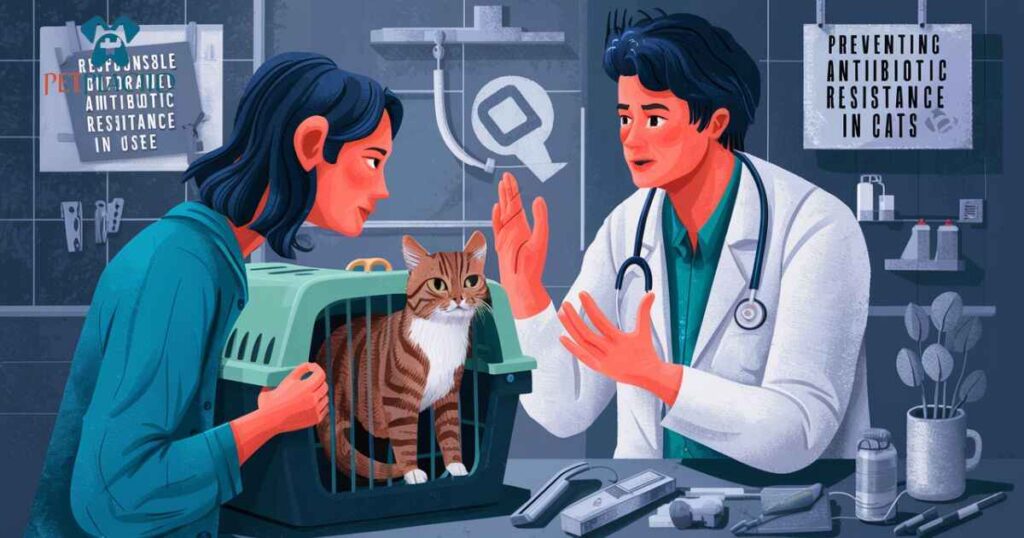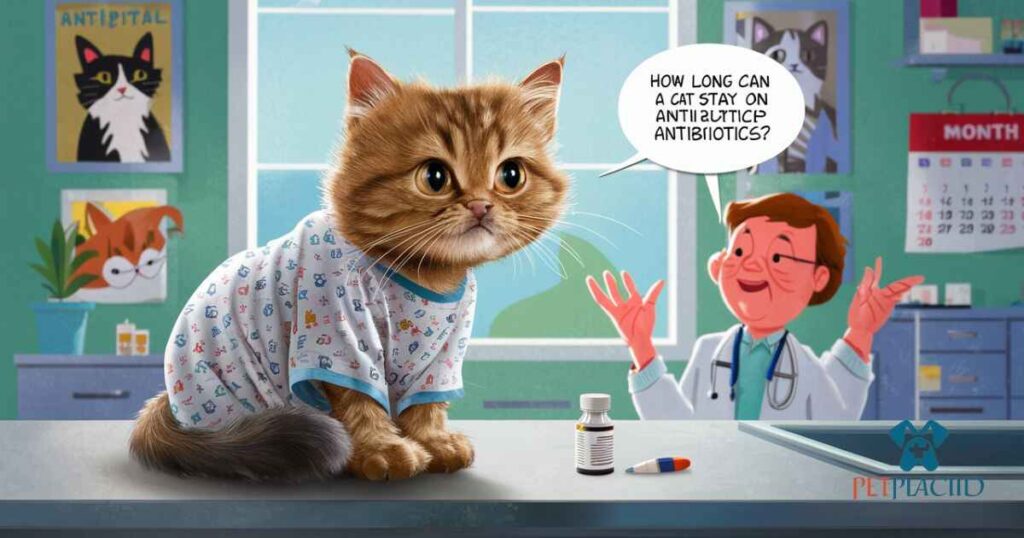Introduction to Antibiotics for Cats
Antibiotics are potent medications used to treat bacterial infections in cats. When prescribed and administered correctly, they can effectively eliminate harmful bacteria, allowing your feline friend’s immune system to recover. However, it’s crucial to follow your veterinarian’s instructions diligently, as antibiotics should never be used without proper diagnosis and guidance.
Understanding the Purpose of Antibiotic Treatment
Antibiotics may be prescribed for cats to address various bacterial infections, such as:
- Upper respiratory infections
- Skin infections (e.g., abscesses, wounds)
- Urinary tract infections
- Post-surgical infections
It’s important to note that antibiotics are only effective against bacterial infections and will not work for viral illnesses or other non-bacterial conditions. Their primary purpose is to eliminate harmful bacteria from the body, giving the cat’s immune system the opportunity to fight off the infection and recover.
Factors Influencing Antibiotic Duration for Cats
The duration of antibiotic treatment for cats can vary depending on several factors:
- Type and severity of the infection: More severe or deep-rooted infections may require longer courses of antibiotics.
- Cat’s age, health status, and overall condition: Kittens, senior cats, or those with compromised immune systems may require longer treatment durations.
- Specific antibiotic prescribed and its dosage: Different antibiotics have varying potencies and dosing regimens, affecting the treatment duration.
- How well the cat responds to the treatment: If the cat shows a positive response and improvement, the duration may be shorter. Lack of improvement may necessitate a longer course.
Importance of Proper Diagnosis Before Antibiotic Use
Before starting any antibiotic treatment, it’s crucial to obtain an accurate diagnosis from a licensed veterinarian. Improper or indiscriminate antibiotic use can lead to several issues, including:
- Antibiotic resistance: Overuse or misuse of antibiotics can cause bacteria to develop resistance, making infections harder to treat in the future.
- Disruption of the cat’s gut flora: Antibiotics can kill beneficial bacteria in the digestive system, leading to complications like diarrhea or yeast infections.
- Masking underlying conditions: Treating symptoms without addressing the root cause can delay proper treatment and allow the condition to worsen.
To ensure accurate diagnosis, provide your veterinarian with detailed information about your cat’s symptoms, medical history, and any recent changes in behavior or environment.
Common Types of Antibiotics Prescribed for Cats

Here are some of the most commonly prescribed antibiotics for cats, along with their typical use cases and potential side effects:
| Antibiotic | Common Uses | Possible Side Effects |
|---|---|---|
| Amoxicillin | Skin infections, respiratory infections, dental infections | Digestive upset, allergic reactions |
| Cephalexin | Skin infections, urinary tract infections, respiratory infections | Diarrhea, vomiting, loss of appetite |
| Doxycycline | Respiratory infections, tick-borne diseases, skin infections | Photosensitivity, digestive upset, loss of appetite |
| Metronidazole | Anaerobic bacterial infections, inflammatory bowel disease | Neurological side effects, loss of appetite |
“It’s important to remember that antibiotics should only be given as directed by a veterinarian, who will consider the specific condition, antibiotic choice, and appropriate dosage for your cat.” – Dr. Emily Parker, DVM
Guidelines for Administering Antibiotics to Cats
Giving antibiotics to cats can be challenging, but following these guidelines can make the process smoother:
- Read and follow instructions carefully: Administer the correct dosage at the specified intervals, and complete the full course of treatment.
- Give with food: Many antibiotics are best absorbed when given with a meal or a small treat.
- Hide in treats or pill pockets: Disguising the medication in a tasty treat or pill pocket can encourage your cat to take it willingly.
- Stay calm: Cats can sense your anxiety, so approaching the situation calmly and positively can make it easier.
- Reward with treats: Offer your cat their favorite treat or playtime after giving the medication to create a positive association.
Even if your cat seems better, it’s crucial to complete the entire course of antibiotics to prevent the infection from recurring.
Monitoring Your Cat’s Response to Antibiotic Treatment
While your cat is on antibiotics, it’s essential to monitor their condition closely for signs of improvement or potential side effects. Here are some things to watch for:
Positive signs of improvement:
- Increased energy and appetite
- Reduced fever or inflammation
- Healing of wounds or skin lesions
- Improved respiratory function (for respiratory infections)
Potential side effects to watch for:
- Digestive issues (vomiting, diarrhea, loss of appetite)
- Allergic reactions (skin rash, swelling, difficulty breathing)
- Neurological symptoms (lethargy, disorientation, seizures)
If you notice any concerning symptoms or lack of improvement, consult your veterinarian immediately. They may need to adjust the treatment plan or address potential complications.
Potential Side Effects and Risks of Prolonged Antibiotic Use
While antibiotics are essential for treating bacterial infections, prolonged or unnecessary use can lead to various side effects and risks:
- Digestive issues: Antibiotics can disrupt the balance of beneficial gut bacteria, leading to diarrhea, vomiting, and other digestive problems.
- Allergic reactions: Some cats may develop allergic responses to certain antibiotics, ranging from mild skin reactions to severe anaphylaxis.
- Antibiotic resistance: Overuse or misuse of antibiotics can contribute to the development of antibiotic-resistant bacteria, making infections harder to treat in the future.
- Disruption of the immune system: Long-term antibiotic use can weaken the cat’s immune system, increasing susceptibility to other infections or illnesses.
To mitigate these risks, it’s crucial to follow the prescribed duration and dosage precisely and not continue antibiotics beyond the recommended timeframe without veterinary guidance.
The Role of Veterinary Supervision in Antibiotic Therapy
Veterinarians play a crucial role in ensuring the safe and effective use of antibiotics in cats. Here’s how they contribute to successful antibiotic therapy:
- Accurate diagnosis: Veterinarians can perform necessary tests and examinations to identify the underlying bacterial infection accurately.
- Appropriate antibiotic selection: Based on the type of infection and the cat’s medical history, they can choose the most suitable antibiotic and dosage.
- Monitoring and adjustments: During follow-up visits, veterinarians can monitor the cat’s response to the treatment and make adjustments if necessary.
- Preventing misuse: By providing clear instructions and guidance, veterinarians help prevent antibiotic misuse and promote responsible use.
It’s essential to maintain open communication with your veterinarian throughout the antibiotic treatment process and seek professional guidance rather than self-medicating your cat.
Recommended Post: Why Does My Dog Look At Me When He Eats ?
Duration of Antibiotic Treatment for Various Cat Health Conditions
While the specific duration of antibiotic treatment can vary based on individual cases, here are some general timeframes for common cat health conditions:
- Upper respiratory infections: 7-14 days
- Skin infections (mild to moderate): 10-14 days
- Urinary tract infections: 7-14 days
- Dental infections: 7-10 days
- Wound or abscess infections: 10-14 days or longer, depending on severity
“The duration of antibiotic treatment is not a one-size-fits-all approach. It depends on the specific infection, the cat’s response to treatment, and the veterinarian’s clinical judgment.” – Dr. Sarah Wilson, DVM, DACVIM (Small Animal Internal Medicine)
It’s crucial to follow your veterinarian’s specific instructions for each situation, as the actual duration may vary based on the severity of the infection, the cat’s overall health, and their response to the treatment.
Recognizing When Antibiotic Treatment Is No Longer Necessary
While completing the full course of prescribed antibiotics is essential for treating bacterial infections in cats, there may come a point when the treatment is no longer necessary. Knowing when to discontinue antibiotic therapy is crucial to avoid potential side effects and promote responsible antibiotic use.
Here are some signs that may indicate the infection has cleared, and antibiotics can be safely discontinued:
- Complete Resolution of Symptoms: One of the most obvious indicators is the complete disappearance of symptoms related to the infection. This may include the absence of fever, improved energy levels, healing of wounds or skin lesions, and a return to normal appetite and behavior.
- Negative Test Results: Your veterinarian may recommend running diagnostic tests, such as cultures or blood work, to confirm the absence of the bacterial infection. Negative test results can provide strong evidence that the antibiotics have successfully eliminated the harmful bacteria.
- Significant Improvement in Overall Condition: Beyond just the resolution of specific symptoms, you may notice a marked improvement in your cat’s overall well-being. This could include increased activity levels, a brighter demeanor, and a return to their typical playful or affectionate behavior.
It’s important to note that while these signs can be positive indicators, they should not be interpreted as definitive evidence that antibiotic treatment is no longer needed. Discontinuing antibiotics too soon can lead to a recurrence of the infection or the development of antibiotic resistance.
“Even if your cat seems to have recovered, it’s crucial not to stop antibiotics without consulting your veterinarian first. Premature discontinuation can undo the progress made and make the infection harder to treat in the future.” – Dr. Emily Parker, DVM
Your veterinarian will consider various factors, such as the type and severity of the infection, the specific antibiotic used, and your cat’s overall health status, when determining the appropriate duration of antibiotic therapy.
Steps to Safely Discontinue Antibiotic Therapy
Once your veterinarian has determined that the antibiotic course can be completed, follow these steps to safely discontinue the therapy:
- Complete the entire course: Ensure that you administer the full prescribed duration of antibiotics, even if your cat seems better.
- Gradual tapering (if recommended): In some cases, your veterinarian may recommend a gradual tapering of the antibiotic dosage to avoid potential withdrawal symptoms or a rebound effect.
- Monitor for relapse: Closely observe your cat for any signs of recurring symptoms or infection after stopping the antibiotics.
- Follow-up visit: Schedule a follow-up appointment with your veterinarian to ensure the infection has been fully cleared and to address any remaining concerns.
It’s important to never abruptly stop antibiotic treatment without veterinary guidance, as this can increase the risk of antibiotic resistance and treatment failure.
Preventing Antibiotic Resistance in Cats

Antibiotic resistance is a growing concern in both human and veterinary medicine. It occurs when bacteria develop the ability to survive and multiply despite the presence of antibiotics designed to kill them. To help prevent antibiotic resistance in cats, it’s essential to follow these responsible practices:
- Follow dosage instructions precisely: Administering the correct dosage at the recommended intervals is crucial for effective treatment and preventing resistance.
- Complete the full course: Stopping antibiotics too soon can allow surviving bacteria to develop resistance.
- Avoid unnecessary use: Antibiotics should only be used when prescribed by a veterinarian for confirmed bacterial infections.
- Good hygiene and sanitation: Proper cleaning and disinfection of the cat’s living environment can reduce the need for antibiotics by preventing infections.
By using antibiotics judiciously and following veterinary guidance, we can help preserve the effectiveness of these life-saving medications and ensure they remain viable treatment options for future generations of cats.
Alternative Approaches to Supporting Cat Health
While antibiotics are essential for treating bacterial infections, there are complementary or alternative approaches that may support your cat’s overall health and well-being:
- Probiotics: These beneficial bacteria can help restore the balance of gut flora disrupted by antibiotic use, promoting better digestion and immune function.
- Immune-boosting supplements: Certain supplements, such as vitamin C, echinacea, and omega-3 fatty acids, may help strengthen the cat’s immune system and support recovery.
- Herbal remedies: Some herbs, like goldenseal and oregano oil, have natural antimicrobial properties and may be used in conjunction with conventional treatments for certain conditions.
However, it’s important to note that these alternative approaches should not replace prescribed antibiotics for bacterial infections. Instead, they can be used as complementary therapies under the guidance of a holistic or integrative veterinarian.
By combining conventional and alternative approaches, you can provide comprehensive support for your cat’s health and recovery while minimizing the risks associated with prolonged antibiotic use.
Summary
In conclusion, understanding the appropriate duration and responsible use of antibiotics is crucial for ensuring the well-being of your feline companion. By following your veterinarian’s instructions, monitoring your cat’s response, and practicing responsible antibiotic stewardship, you can effectively treat bacterial infections while minimizing the risks of side effects and antibiotic resistance. Remember, a well-informed and proactive approach to your cat’s health can lead to a happier, healthier life together.







